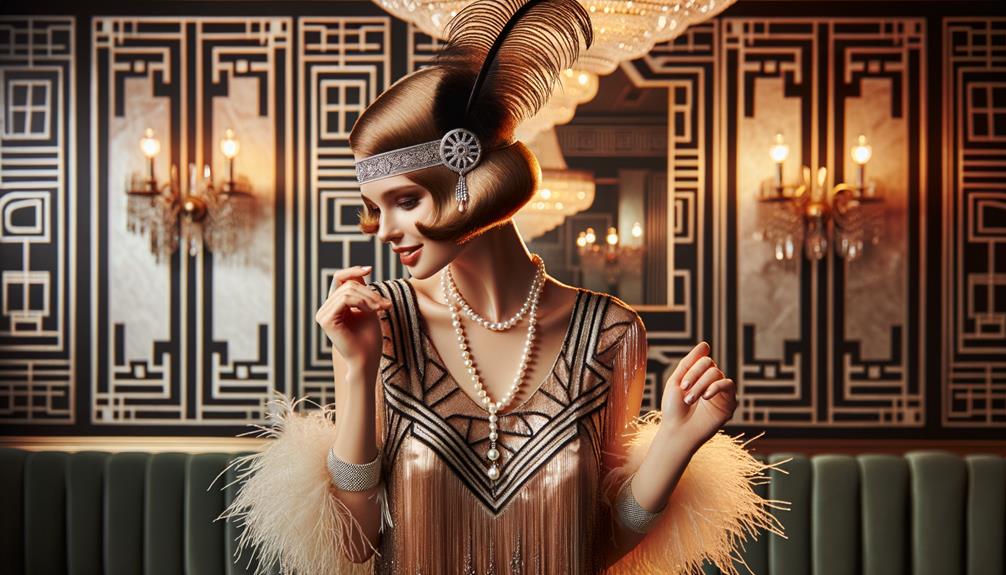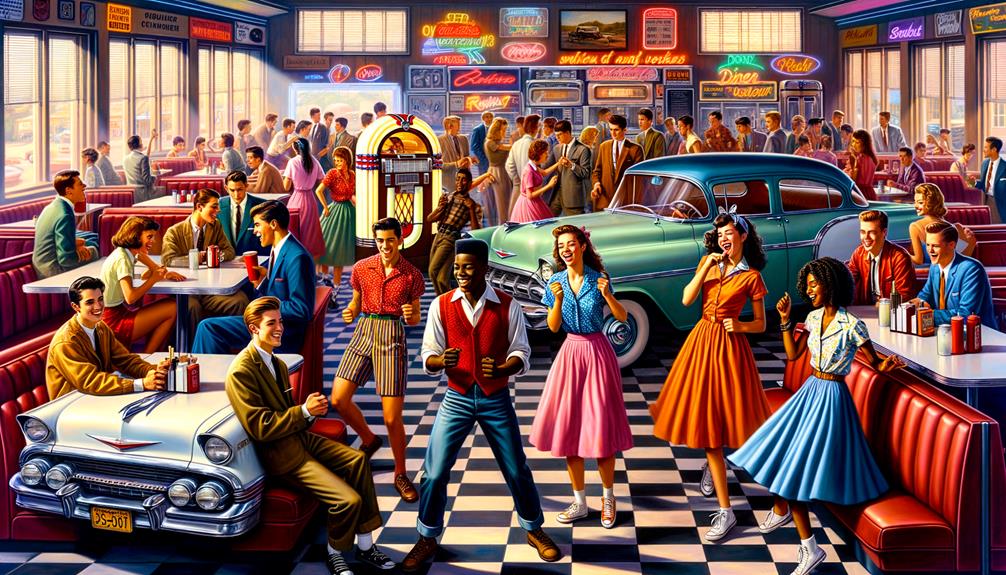The little black dress has long been more than just a piece of clothing – it's an enduring symbol of elegance and transformation. It all started with Coco Chanel in 1926, when she redefined simplicity as sophistication and made it accessible. Decades later, Audrey Hepburn immortalized the dress in "Breakfast at Tiffany's," turning it into an emblem of timeless charm. Over the years, countless designers have reimagined the classic, yet its core essence remains unchanged. The little black dress continues to be a versatile staple for women, a testament to style and legacy. Each iteration tells a part of its captivating story, inviting us to discover even more.
Coco Chanel's Revolutionary Design
In 1926, Coco Chanel revolutionized fashion when she introduced the little black dress in Vogue. She transformed black from a color of mourning into a symbol of timeless elegance. It's remarkable how a single piece of clothing carried such profound cultural impact. Chanel's vision was truly groundbreaking.
She aimed to strip away excess and focus on simplicity, functionality, and affordability. This wasn't just a dress; it was a declaration that elegance could be accessible to every woman. Chanel introduced what would soon be dubbed the 'Chanel's Ford,' a nod to the Model T Ford, both for its ubiquity and its democratizing influence.
The little black dress was meant to be versatile, easily styled for any occasion, embodying Chanel's belief that fashion should be practical yet stylish. It's fascinating how she saw the potential in black, a color confined to mourning attire, and reinvented it as a chic staple in every woman's wardrobe.
Chanel's design wasn't merely about fabric and stitches; it was about a mindset shift. She transformed simplicity into sophistication, making the little black dress an enduring symbol of innovation and timeless grace.
1920s: The Birth of a Classic
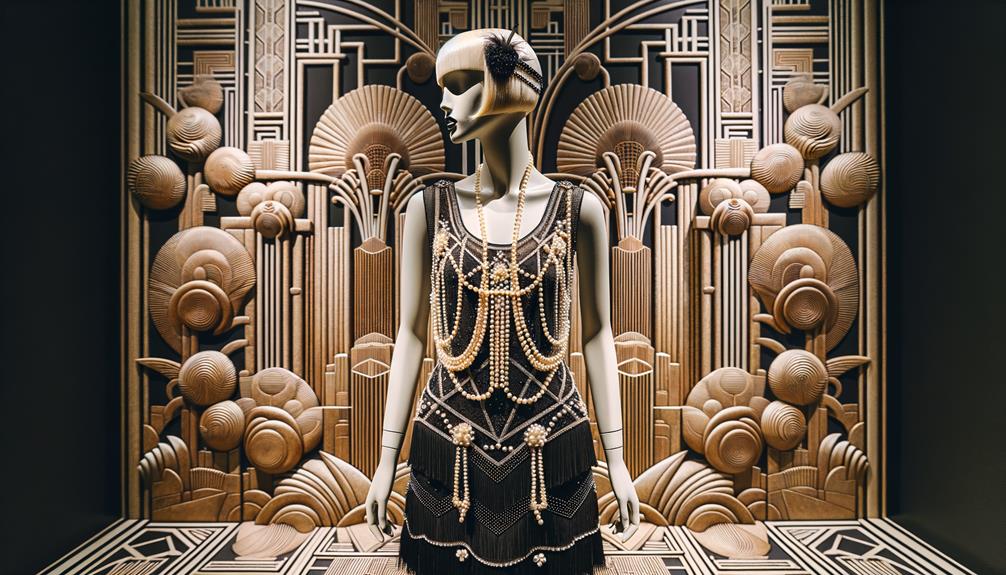
The 1920s marked the birth of a classic as Chanel's little black dress redefined elegance and simplicity. In 1926, Coco Chanel introduced this revolutionary garment in Vogue, making black a color of sophistication and everyday style, rather than just for mourning. Her vision was transformative – a simple, knee-length black dress in crepe de chine that became a versatile staple for women everywhere.
Chanel's dress wasn't just a piece of clothing; it was a statement. Nicknamed 'Chanel's Ford' for its affordability and versatility, it mirrored the resilience of the Great Depression era. Before this, black was reserved for somber occasions, but Coco saw its potential to embody both strength and elegance.
Chanel, with her discerning eye, knew that a string of pearls would elevate the dress's timeless appeal. This accessory became a signature, a testament to Chanel's genius at blending simplicity with luxury. As the dress gained popularity, it quickly transcended its initial purpose, becoming a symbol of Hollywood glamour by the 1940s. It was more than just a garment – it was an emblem of an era, a harbinger of modern fashion's enduring allure.
Audrey Hepburn's Iconic Moment
When I think of timeless style, Audrey Hepburn's iconic look in Breakfast at Tiffany's immediately comes to mind. Her sleek Givenchy dress not only defined sophisticated elegance but also solidified the little black dress as an enduring fashion staple. This single cinematic moment transformed our perception of style, proving that simplicity can have a profound impact.
Breakfast at Tiffany's Impact
Audrey Hepburn's appearance in the 1961 film *Breakfast at Tiffany's* left an indelible mark on fashion history. Her portrayal of Holly Golightly, dressed in a simple yet elegant black Givenchy sheath dress with a pearl necklace, radiated sophistication and versatility.
This iconic outfit, designed by Hubert de Givenchy, demonstrated how a little black dress could be dressed up or down, becoming a timeless staple in every woman's wardrobe. The film's enduring popularity transformed the little black dress from a mere outfit into a cultural and fashion icon, synonymous with refined yet accessible elegance.
Hepburn's legendary performance and the visual impact of the black Givenchy dress cemented the little black dress's status as a symbol of timeless fashion innovation. It wasn't just a costume; it became a representation of Hepburn's image, forever linking her with the epitome of effortless style.
Timeless Elegance Defined
Audrey Hepburn's iconic appearance in Breakfast at Tiffany's redefined our understanding of timeless elegance. Her portrayal of Holly Golightly, dressed in a simple yet impeccably chic Givenchy gown, elevated the little black dress to an enduring symbol of sophistication.
Hepburn's effortless style showed that true elegance is not about opulence, but about an understated grace. The dress's versatility, which allowed it to be dressed up or down, cemented its status as a wardrobe staple for women. Hepburn's poise and elegance brought Coco Chanel's vision to life, proving that timeless style transcends trends.
The black dress from Breakfast at Tiffany's didn't just adorn Audrey; it defined an era. It demonstrated that elegance could be effortless, perpetually relevant, and deeply inspiring. This timeless simplicity continues to influence modern fashion, proving that the essence of style often lies in the purity of design.
Hollywood's Love Affair
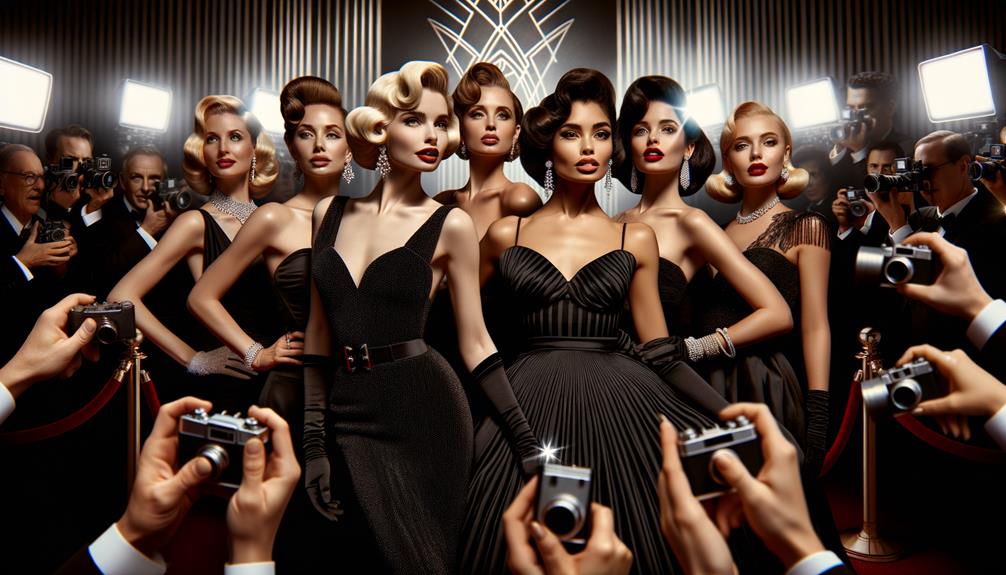
Hollywood's longstanding love affair with the little black dress began in the golden age of cinema, forever linking glamour and simplicity. Audrey Hepburn's iconic turn in Breakfast at Tiffany's solidified this garment's status. Her Givenchy-designed dress was more than just fabric – it embodied elegance, charm, and sophistication, setting a timeless benchmark in Hollywood.
Throughout the 1950s and 1960s, the little black dress continued to captivate the silver screen. Elizabeth Taylor and Marilyn Monroe wore it with such poise that it became synonymous with star power. Sophia Loren's nautical-inspired variations added a touch of Mediterranean allure, showcasing its adaptability.
Joan Crawford's sleek black dress with a tulle neckline in 1962 demonstrated its versatility, shifting effortlessly from glamorous evenings to television appearances. Meanwhile, Catherine Deneuve's black dress adorned with a gold square belt and metal embellishments in 1966 illustrated its capacity for modern enhancements.
Reflecting on Hollywood's embrace of the little black dress, it's clear this garment transcends eras and trends. It's a canvas for innovation, embodying the essence of style and sophistication while remaining eternally relevant.
Modern Interpretations
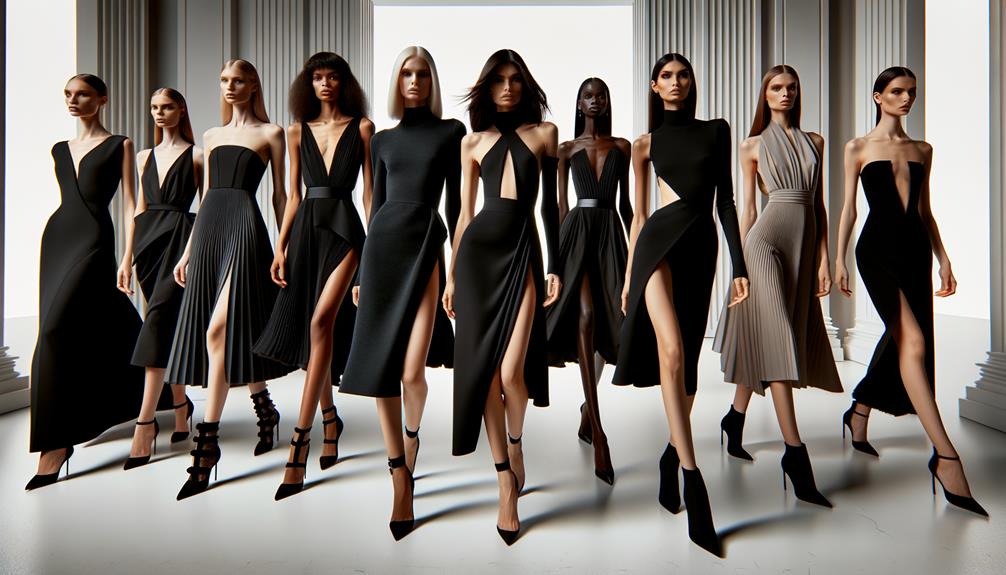
While Hollywood's golden age cemented the little black dress as a timeless symbol of elegance, today's designers and celebrities continue to reinvent this classic piece, blending tradition with modern innovation. The reinterpretations reflect the dress's enduring appeal. Designers like Tom Ford, Alexander McQueen, and Victoria Beckham have all put their unique spins on the LBD, experimenting with new silhouettes, luxurious fabrics, and intricate details.
The Hinterland Dress pattern from Muna Patterns is an example of how the LBD can be adapted for the contemporary wardrobe. Its A-line shape offers a flattering fit, and the versatile styling options make it suitable for various occasions. Similarly, Muna Patterns' little black swing dress pattern provides a fresh, playful take on the classic design, appealing to those who appreciate a mix of tradition and modernity.
Celebrities like Gwyneth Paltrow, Mischa Barton, and Charlize Theron have showcased these modern interpretations on the red carpet, proving the LBD's continued relevance in the high-fashion world. These adaptations capture the essence of an iconic piece, evolving to meet the desires of a fashion-forward audience.
Enduring Fashion Legacy
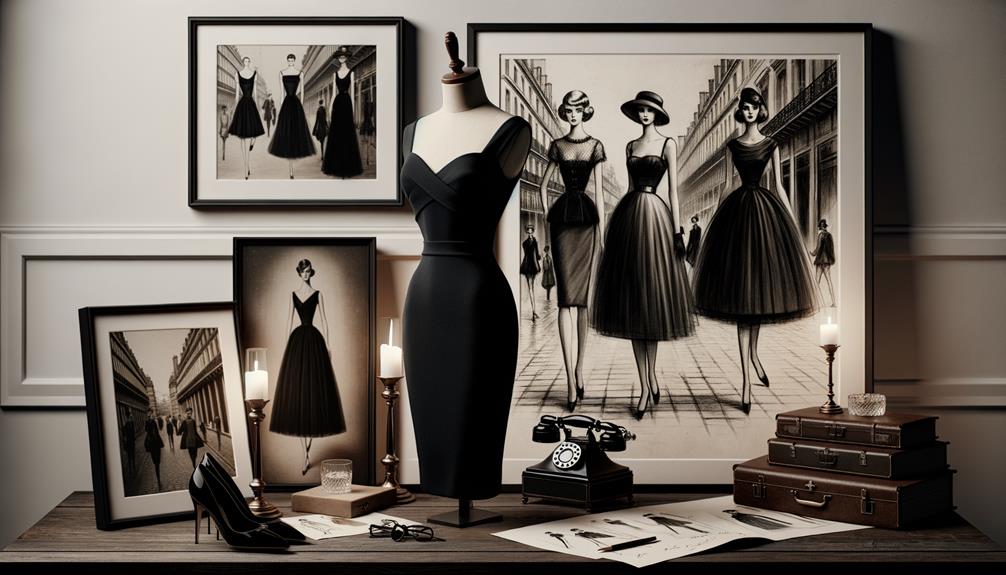
The little black dress has long been a wardrobe staple, captivating us for nearly a century with its timeless elegance and versatility. It's not just a piece of clothing – it's a cultural icon that embodies sophistication and adaptability like no other. As fashion trends come and go, this classic dress has endured, its enduring appeal a testament to its unparalleled status in the fashion world. What is it about this simple yet sophisticated garment that has kept it at the forefront of style for so long? Its ability to be dressed up or down, to flatter a variety of figures, and to remain relevant through the decades is truly remarkable. The little black dress is more than just a wardrobe essential; it's a sartorial embodiment of the enduring power of good design.
Timeless Wardrobe Essential
The little black dress is more than just a piece of clothing – it's a timeless icon of elegance and versatility. From Coco Chanel's groundbreaking design in 1926 to Audrey Hepburn's memorable portrayal in Breakfast at Tiffany's, this garment has transcended decades to become a wardrobe staple.
Chanel's initial creation brought simplicity and accessibility to women's fashion, yet it maintained an elegant appeal that has endured. Reflecting on the LBD's journey, we see how it has continuously adapted while retaining its core essence. Designers have reinterpreted it over the years, each iteration offering something new while preserving its allure.
The LBD's ability to flatter various body types and suit multiple occasions is unparalleled. Its versatility extends beyond just style – it represents a woman's confidence and timeless grace. In a world chasing constant trends, the little black dress stands as a symbol of enduring fashion. It's not just about style; it's about a legacy that will continue to evolve and inspire.
Iconic Style Influence
The little black dress has had a profound impact on the ever-evolving world of fashion. Coco Chanel's revolutionary design in 1926 transformed it into a symbol of elegance, sophistication, and modernity. Audrey Hepburn's iconic portrayal in Breakfast at Tiffany's cemented its enduring influence.
Chanel's simple yet bold creation allowed the little black dress to transcend fleeting trends and become a timeless wardrobe essential. Its versatility, the ability to be dressed up or down, has ensured its perpetual relevance, making it a staple in women's closets worldwide.
Designers have continually reinvented the little black dress, each iteration a nod to its storied past while pushing the boundaries of innovation. Its cultural significance and symbolic power are unparalleled, underscoring its status as a fashion icon.
It's fascinating how a single piece of clothing can encapsulate decades of style evolution, yet remain fundamentally unchanged in its essence. The little black dress from Coco Chanel continues to inspire, embodying the perfect blend of historical legacy and contemporary allure.
Frequently Asked Questions
What Was the Impact of Coco Chanel's Little Black Dress?
Coco Chanel's iconic little black dress came to symbolize elegance and simplicity. It serves as a reminder that true innovation often lies in accessibility and timeless design. Chanel's creation challenged fashion norms, empowering women with a versatile and enduring style icon. This design reshaped the industry forever.
What Influenced the Little Black Dress?
The little black dress has been a fashion staple for decades, and its origins can be traced back to various societal and cultural influences. In the 1920s, Coco Chanel's vision for a simple, versatile, and elegantly understated dress resonated with women seeking to break free from restrictive, ornate styles of the past.
Over the years, the little black dress has evolved, adapting to the sensibilities and needs of each era. Hollywood's embrace of the style, particularly in the 1930s and 1940s, cemented its status as a symbol of timeless sophistication. As the decades passed, the little black dress continued to reflect the changing attitudes and lifestyles of women, becoming a canvas for experimentation and self-expression.
Economic factors have also played a role in the enduring popularity of the little black dress. Its affordability and ability to be dressed up or down have made it accessible to women across various income levels, contributing to its widespread appeal. The little black dress has become a wardrobe staple, a reliable choice for any occasion, and a testament to the power of simplicity in fashion.
What Was the Effect of the Little Black Dress?
The black dress became a fashion icon almost by accident. What started as a simple, understated garment transformed the way people thought about elegance and style. Suddenly, the unassuming little black dress was everywhere, proving that sometimes the most humble pieces can make the biggest impact. It became a staple in many women's closets, effortlessly pulling together outfits and conveying a sense of timeless sophistication. The widespread popularity of the little black dress showed how a single clothing item could shape cultural perceptions of fashion and beauty. Its enduring influence is a testament to the power of minimalism and the idea that less can truly be more when it comes to making a statement.
When Did Audrey Hepburn Wear the Little Black Dress?
Audrey Hepburn's little black Givenchy dress from the 1961 film Breakfast at Tiffany's has become an enduring symbol of elegance and sophistication. The way it effortlessly transforms the perception of fashion's versatility is truly captivating. This iconic dress continues to inspire and influence style decades after its debut, solidifying Hepburn's status as a timeless fashion icon.
Conclusion
As I reflect on the little black dress, I envision Coco Chanel sketching her pioneering design, a simple yet striking silhouette. Audrey Hepburn, elegant and timeless, graces the screen in 'Breakfast at Tiffany's,' forever transforming fashion. Hollywood's embrace, modern interpretations, and its enduring legacy remind me that this garment is more than fabric – it's history, elegance, and empowerment stitched into every seam. The little black dress isn't just worn; it's lived.



